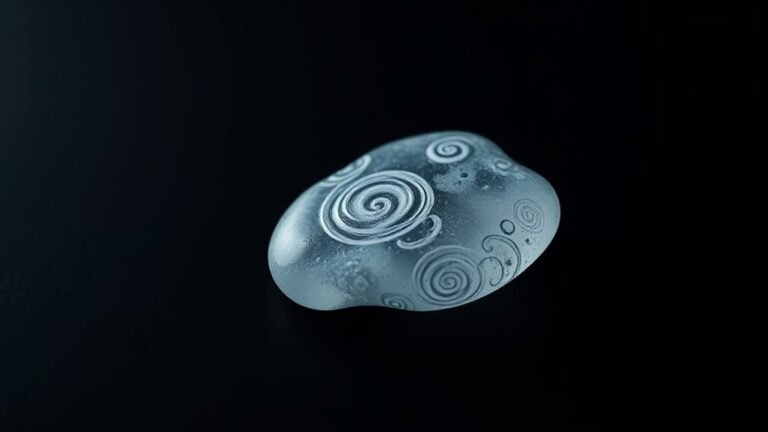12 Spiritual Meanings of Hiding Corpse: Divine Signs
Have you thought about what hiding a corpse means? This act can relate to grief, change, and spiritual awakening. When you see this strong image, it invites you to look at your hidden feelings and fears. Could this hiding be a sign from a higher power about the changes you need in your life? As you think about it, you might find new insights and understandings you hadn't noticed before.
Key Takeaways
- Hiding a corpse may symbolize a need to conceal unresolved grief or emotional burdens, prompting self-reflection and healing.
- The act can indicate spiritual guidance, suggesting individuals are being nudged to confront and process unacknowledged feelings.
- It may represent the cycle of life, urging recognition that endings lead to new beginnings and personal transformation.
- Such occurrences can signify divine signs urging growth, emphasizing trust in one's journey through loss and renewal.
- Engaging with the symbolism of a hidden corpse invites exploration of deeper connections with self and others, enhancing spiritual awareness.
The Cycle of Life and Death
As you think about life and death, remember that every end brings a new start. Life goes through cycles. These cycles remind you that endings are changes, not just closures.
Changes, like the end of seasons, relationships, or goals, help you grow. For example, a caterpillar goes into a chrysalis. This may seem like the end, but it's really a transformation waiting to happen.
Transformation and Rebirth
Life's cycles create moments of change and renewal.
You're in a process of personal growth, where releasing the past becomes crucial. Each ending leads to a new beginning, offering opportunities for development. Accept these moments, as they bring clarity and help you through uncertainty.
In these experiences, you discover your true self and shape who you're meant to become. By letting go of old habits, you create space for new ideas and meaningful connections.
Trust that every change brings you closer to your true self, fostering a sense of belonging that supports both your spirit and those around you.
Hidden Aspects of the Self
While you explore your inner self, you may discover important truths. Through self-examination, you can find valuable insights that have stayed hidden. Accepting these parts of yourself can lead to personal growth and deeper connections.
- Unspoken Dreams: Identify the goals you have set aside.
- Suppressed Emotions: Recognize feelings you have overlooked.
- Unique Talents: Discover creative abilities that are ready to emerge.
- Deepest Fears: Confront the worries that hinder your progress.
Engaging with these aspects can transform your understanding of yourself and enhance your life journey. Each step you take opens doors to new possibilities and strengthens your sense of self.
Confronting the Shadows
Confronting the shadows within yourself is key for healing and growth. Engaging in shadow work lets you explore deeper truths hidden inside.
You may feel fear and resistance, but awareness can change those fears into wisdom. Acknowledging your shadows helps you become more authentic, connecting you to yourself and others.
Facing these hidden parts reveals not just pain, but also strength and resilience. By doing so, you honor your journey and promote a sense of belonging for yourself and those around you.
Embrace your shadows; they can lead to deeper connections and inner peace.
Releasing Burdens and Attachments
Embracing your shadows helps you release burdens and attachments that hold you back. Acknowledging these aspects of yourself opens the door to healing. Follow these steps to let go of your burdens and attachments:
- Identify Emotional Weights: Recognize what holds you back, like fear, guilt, or past experiences.
- Practice Forgiveness: Let go of grudges against yourself and others to free your spirit.
- Cultivate Mindfulness: Stay present and observe your thoughts without judgment. Allow your insights to come forward.
- Visualize Release: Imagine tying your burdens to a balloon and watching them float away, giving you a sense of lightness.
This journey helps you connect with your true self.
Releasing these constraints brings a deeper sense of belonging and peace to your spirit. Embrace the process and enjoy the lightness it brings.
The Call for Inner Healing
The call for inner healing is present in your heart. It encourages you to face the wounds that remain hidden. Inner reflection can bring a sense of peace—a gentle prompt to examine your feelings.
In this safe space, you can embrace vulnerability and understanding. As you confront fears and past hurts, allow yourself to let go of emotions. Imagine each tear as a cleansing flow, removing the burden of unexpressed grief.
This journey isn't just for you; it connects you with others who also seek healing, creating a community of shared stories. Trust this process.
Within this exploration lies the chance for change, guiding you to a renewed sense of belonging and completeness.
Secrets and Unresolved Issues
As you explore yourself, hidden truths and unresolved issues may come to light. This journey requires dedication to discovering these truths and building a deeper connection with yourself.
Here are some clear steps to consider:
- Recognize Your Secrets: Acknowledge the secrets you have; they influence your reality.
- Write About Your Feelings: Journaling can help clarify emotions that lie beneath.
- Reach Out for Help: Ask friends or family for support; being open can deepen relationships.
- Practice Healing Activities: Engage in meditation or creative outlets to support self-discovery.
Symbolism of Grief and Loss
Grief and loss feel like heavy burdens in your heart. These emotions arise from the deep connections you formed with others. Different cultures provide various meanings to these feelings, showing that you share your sorrow with many.
Each tear you cry expresses your love and the impact of the loss you feel. As you experience this pain, you might also notice that loss can lead to personal growth.
Traditions and rituals can help you find comfort and connect with others who are grieving. Accepting these emotions allows you to remember your loved ones while transforming your grief into a deep recognition of the love you shared.
Learning From the Past
Finding meaning in your grief leads to reflections on the past. Understanding historical context can clarify your feelings and show how others have faced loss. Here are some cultural interpretations to assist your journey:
- Mourning Traditions: Learn about rituals that honor those who've passed away.
- Wisdom from Ancestors: Think about lessons from those who came before you.
- Cultural Symbols: Examine how artifacts express grief and strength.
- Community Support: Value the comfort found in shared experiences of loss.
As you review memories, remember that every scar tells a story.
Metaphors for Change
Change can feel overwhelming, but it offers a chance for growth. Picture a caterpillar turning into a butterfly. This journey brings you closer to your true self.
Accept the unknown; it's a vital part of your growth. Like a snake shedding old skin, let go of what no longer helps you.
As you experience change, remember you aren't alone. Connect with others who understand your challenges.
Change can be intimidating, but it leads to new beginnings and deeper connections. Welcome it, and let it light the way to your next chapter.
Divine Guidance Through Adversity
When you encounter challenges, it can feel overwhelming.
However, there's a source of support and guidance available to you. This is where your inner strength can help you navigate tough times.
Here are four clear principles to help you:
- Connect with Others: Talk to people who understand your situation. Sharing what you feel can provide comfort.
- Think About Growth: See your challenges as chances to learn and grow. They can show you how strong you really are.
- Practice Calmness: In chaotic times, take a moment to breathe and gather your thoughts. Mindfulness can help you find clarity.
- Have Faith in the Journey: Trust that every challenge has a reason. It can guide you closer to who you're meant to be.
Through these challenges, you can discover more about your spiritual path and your connection to something greater.
Embracing Spiritual Awakening
Embracing spiritual awakening can change your view and deepen your understanding of life. This journey allows you to explore your inner self and discover new truths.
Personal growth happens in quiet moments, where reflection brings important insights. As you experience these changes, notice the signs that guide you in self-discovery.
You'll connect more with your true self and others, creating a sense of belonging in the universe. Each lesson you learn helps shape who you are.
This journey isn't just for you; it's a shared experience of many seeking light and connection. Enjoy the process, and allow the awakening to enrich your life.
Frequently Asked Questions
What Are the Cultural Interpretations of Hiding a Corpse?
Cultural interpretations of hiding a corpse vary widely. Different communities have unique burial practices based on their beliefs. These traditions show respect and remembrance for the deceased. They also highlight the need for connection among people. Each culture offers a way to cope with loss and honor life.
How Does Hiding a Corpse Relate to Personal Fears?
Hiding a corpse represents your personal fears and anxieties. It shows the deep fears you may not realize you have. This act symbolizes your difficulty with emotions. It also highlights your need to face what you keep hidden inside. You search for acceptance and belonging, especially when dealing with life's endings.
Are There Historical Examples of Corpse Hiding With Spiritual Significance?
Historical examples of grave concealment appear in many cultures. These practices often aimed to protect spirits or maintain connections to loved ones after death. For instance, some cultures buried their dead in hidden locations to shield them from harm or to honor their memory. This shows the human desire for connection and understanding that persists even after death. Such rituals reveal how different societies address their beliefs about life and the afterlife, making the topic both fascinating and significant.
What Rituals Are Associated With the Discovery of Hidden Corpses?
When you find hidden corpses, follow grief rituals and burial practices to honor the deceased. These actions can help you cope with your feelings of loss. Engaging in these rituals creates a sense of connection to those who have passed away. It can provide comfort during difficult times.
Can Hiding a Corpse Signify Unresolved Ancestral Trauma?
Hiding a corpse can show unresolved ancestral trauma. This act may indicate a need for healing within a family. Understanding this trauma allows you to connect with your roots. This connection can create a stronger sense of belonging and clarity about your family's history. Embracing this knowledge can lead to healing and a greater understanding of your identity.

Naomi White is an esteemed expert in spirituality with a passion for uncovering the hidden meanings and messages within divine symbols. Naomi’s work aims to bridge the gap between the mystical and the everyday, helping others find guidance and inspiration in the symbols that surround us all.

















